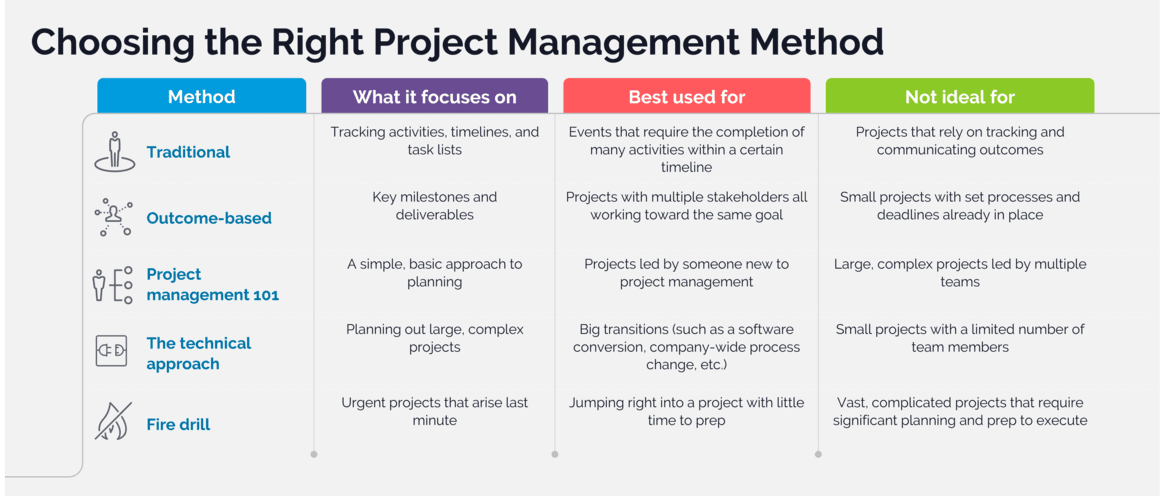Project management is a complex area of business with almost endless strategies, processes, and ideas. You might be feeling overwhelmed with what type of project management to use on your next initiative. As managers of hundreds of projects, we know a little about this complex world. We’ve highlighted a few of the top methods out there with some tips on when or where to use each approach.
Method 1: Traditional project management
Method 2: Outcome-based project management
Method 3: Project management 101
Method 4: The technical approach
Method 5: Project management for fire drills
For starters, when selecting the right project management method, it’s essential to align the method with the project’s specific needs and requirements. Consider factors such as project size, complexity, and the industry in which you operate. For example, traditional project management methods are better for well-defined projects with established processes. Outcome-based project management is ideal for projects requiring significant stakeholder collaboration and a focus on strategic goals.
Managing timelines and deliverables can also be challenging, particularly for large and complex projects. Each method of project management offers different strategies for staying on track. Traditional methods focus on detailed task lists and schedules, while outcome-based approaches emphasize milestones and meeting specific initiatives. A technical approach integrates rigorous planning and small, manageable deliverables to ensure continuous progress. Understanding these distinctions can help you select a method that aligns with your project’s needs and keeps all team members accountable.
Method 1: Traditional project management
Traditional project management focuses on tracking activities, timelines, and task lists. You can primarily use this method for events. Traditional project management is ideal for:
- Organizing activities: you can track when certain meetings are happening, what deliverables are in progress, or build a logical list of activities, known as a work breakdown structure
- Maintaining established processes: you can keep track of consistent processes and deadlines
- Predicting involvement in a project: from managers to content creators, you can identify contributors
The big challenge with traditional project management is tracking and communicating outcomes when the focus is on tracking activities. For example: how do you identify when 75% of a project is completed? Is it the most important 75%? Or small parts of the project that are less crucial to the outcome?
Method 2: Outcome-based project management
Outcome-based project management focuses on key milestones and deliverables, starting with the strategic vision for the project and developing deadlines from there. We recommend applying this method to projects with multiple stakeholders who are all working toward the same goal. All activities should be achievable given the time and resource constraints, as well as aligned to the bigger picture.
The four main tenets of this type of project management are:
Step 1: Define project parameters
- Define the goals of the project and ensure they are aligned to the overall strategic vision.
- Determine the project’s complexity, factoring in objectives, budget, deadlines, and key stakeholders.
- By starting with your goals and values, your execution plans will be relevant in the short- and long term.
Step 2: Align on project organization
- Figure out your RACI (responsible, accountable, consulted, informed) stakeholders for each milestone and deliverable. Simply put, who has a voice, who has a vote, and who has a veto? Responsible refers to the person completing the task, informed has no voice, consulted has a voice but no vote, and accountable has a vote and veto powers.
- Communicate the roles to all affected parties, and most importantly, secure their approval ahead of time. You will avoid major headaches down the road if all stakeholders know and agree to their level of contribution — it can get ugly when someone without veto power tries to use it.
- Driving alignment on roles and ownership will help people stay focused on meaningful activities, rather than simply assigning tasks.
Step 3: Keep everyone accountable
- Based on the objectives, budget, deadlines, roles, and responsibilities defined in steps one and two, use rhythm of business tools and best practices to keep the project on track.
- Make sure people are meeting their commitments, completing milestones, and finishing the project on time.
Step 4: Manage outcomes
- Track your deliverables, issues, decisions, actions to make them easily accessible to the project team, which will allow you to scale and reduce redundant work.
While outcome-based project management is great for complex projects like a new product launch or program re-design, it might not be necessary for simpler projects or ones with set processes and deadlines already in place.

Method 3: Project management 101
If you’ve just done project management training and are feeling overwhelmed by all the new techniques to try, we’ll help you start. Instead of trying to implement everything at once, we recommend starting with these five strategies:
- Set a regular meeting cadence. Consider a daily re-occurring meeting with your project leadership team. Use the 15 minutes to determine priorities for the day.
- Establish the leadership structure. You might be thinking “after setting up a daily meeting?” Yes. The process of discussing project direction often reveals dependencies and the need to change the leadership team or stakeholders.
- Track decisions. Each time someone makes a decision, document it: Who made it, when, and the rationale. Keep this list visible through an accessible and visible medium. If the topic resurfaces, use the decision log to move forward.
- Focus only on deliverables, not activities. A deliverable is an electronic or physical item you can show, refer to and build upon. Deliverables vary by project and company, but some examples include documents, presentations, reports, product prototypes, applications, and work plans.
- Introduce a simple, one-page timeline. Many timelines are so complicated that the documents are only useful to other project managers. Consider using a simple, one-page timeline with 5-10 key dates. Once you create a simple timeline, you can include additional details as needed.
The advantage of this method is that it's simple, while the downside is that many projects require a more complex methodology. We recommend using this method if you are new to project management and trying out your first project. It can also be useful for projects with a smaller team such as targeted strategic planning or process improvement. For big projects, you might want to consider the next method.
Method 4: The technical approach
When dealing with a large and complex project (like a software conversion, company-wide process change, or other big transition), a technical approach can be your best bet. A few key strategies for this approach:
- Create a centralized plan or roadmap for the project, which could include data migrations, rules of engagement, standard deliverables, and the priorities of execution.
- Create small, separate deliverables so everyone can work and test simultaneously without duplicating efforts.
- Ensure you have the right method before you begin, that everyone involved understands it and that management is on board with the process design.
- Choose a team that can execute efficiently and without guidance at times.
Method 5: Project management for fire drills
What kind of project management do you use when all the previous rules fly out the window? We’ve all had those projects that arise last minute, usually from someone far above our pay grade with an urgent request that requires us to drop other priorities.
Under these conditions, the typical approach is to jump right in. We recommend taking a breath and doing the following first:
- Get clear. What exactly is the need and final deliverable? For example: We need a PowerPoint deck that does what? Who is presenting to whom? And what do we want to convey?
- Get a team. Find a group of people who are willing to move quickly and aren’t already overworked on other projects
- Get a plan. Don’t start the work until you are organized and see a path forward. Think about the steps and how to involve others to do the heavy lifting. Put it in a simple email, a document, or a presentation file.
- Get a rhythm for communication and updates. Determine how to stay in regular contact with the team. We recommend short, regularly scheduled meetings to enable transparency, accountability, adjustments, and decisions. Use the plan to set a mini agenda for each meeting.
Picking the best project management approach for you
When determining the best project management approach for you, consider the specific tools and technologies your organization uses. For instance, integrating project management software that complements your chosen method is more likely to enhance efficiency. Tools like Gantt charts and Kanban boards can be useful for traditional project management, while advanced reporting and analytics are beneficial for outcome-based approaches.
Different ways of working in project management can also influence your choice. Agile methodologies, for example, promote flexibility and iterative progress, making them suitable for projects with evolving requirements. In contrast, more structured approaches may be better for projects with fixed scopes and timelines. Understanding your team’s working style and culture can help you select a project management method that enhances productivity and collaboration. Consider conducting workshops or training sessions to align your team’s approach with the chosen method.
Finally, scalability is also important. Some project management methods are better suited for scaling up as project size and complexity increase. For instance, outcome-based project management is highly adaptable, allowing for adjustments as project goals evolve. Traditional methods might struggle with scalability due to their rigid structure. Assessing how well a method can grow with your project will result in long-term success and reduce the risk of outgrowing your approach. By keeping these factors in mind, you can choose a method that not only meets your current needs but also adapts to future challenges.
Plan now or rework later
There’s not a one-size-fits-all solution for managing projects. Each type of project or situation may require a different strategy. As you think about how to approach your next project, consider one of the approaches above, depending on how complex, ambiguous, or last-minute your project is. You also might take a different approach depending on new you are to project management as a skill. Regardless of what you choose, having a plan ahead of time will save you hassle and rework down the line.
This blog is the second in a series on project management. Check out the first blog in the series on setting up a project.

